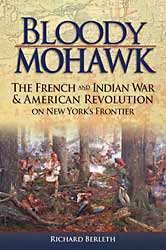| |
 This sweeping historical narrative chronicles events instrumental
in the painful birth of a new nation from the Bloody Morning Scout
and the massacre at Fort William Henry to the disastrous siege of
Quebec, the heroic but lopsided Battle of Valcour Island, the horrors
of Oriskany, and the tragedies of Pennsylvania's Wyoming Valley
massacre and the Sullivan-Clinton Expedition's destruction of the
Iroquois homeland in western New York State. Caught in the middle
of it all was the Mohawk River Valley.
This sweeping historical narrative chronicles events instrumental
in the painful birth of a new nation from the Bloody Morning Scout
and the massacre at Fort William Henry to the disastrous siege of
Quebec, the heroic but lopsided Battle of Valcour Island, the horrors
of Oriskany, and the tragedies of Pennsylvania's Wyoming Valley
massacre and the Sullivan-Clinton Expedition's destruction of the
Iroquois homeland in western New York State. Caught in the middle
of it all was the Mohawk River Valley.
In this narrative history of the Mohawk River Valley and surrounding
region from 1713 to1794, Professor Richard Berleth charts the passage
of the valley from a fast-growing agrarian region streaming with
colonial traffic to a war-ravaged wasteland. Patriots eventually
wrenched the valley from British interests and the Iroquois nations,
but at fearsome cost. When the fighting was over, the valley lay
in ruins and as much as two-thirds of its population lay dead or
had been displaced. But by not holding this vital inland waterway
the gateway to the West, the river between the mountains America
might have lost the Revolution, as well as much or all of the then
poorly defined province of New York.
Berleth explores the relationship of early settlers on the Mohawk
frontier to the Iroquoian people who made their homes beside the
great river. He introduces colonists and native leaders in all their
diversity of culture and belief. Dramatic profiles of key participants
provide perspectives through which contemporaries struggled to understand
events. Sir William Johnson is here first as a shopkeeper and farmer,
then as a brother Mohawk and militia leader, and lastly as a crown
official charged with supervising North American Indian affairs.
We watch Johnson in his final years wrestling with Indian war and
the unraveling of British America. We meet the frontier ambassador
Conrad Weiser, survivor of the Palatine immigration, who agreed
not at all with Johnson or his party. And we encounter the young
missionary, Samuel Kirkland, as he leaves Johnson's household for
a fateful sojourn among the Senecas.
Johnson's heirs did much to precipitate the outbreak of violent
hostilities along the Mohawk in the first months of the War of Independence.
Berleth shows how the Johnson family early sought to save their
patrimony in the valley just as patriot forces maneuvered to win
Native American support or, at least, neutrality. When Joseph Brant,
Thayendanegea, rushed Native Americans to war behind the British,
it fell to General Philip Schuyler, wealthy scion of an old Albany
family, to find a way to protect the Mohawk region from British
incursion. His invasion of Canada fails; his tattered army fights
at Valcour Island, Ticonderoga, Hubbardton, retreating steadily.
Not until on the line of the Mohawk is the enemy stopped.
But the battles of Oriskany, Fort Stanwix, Saratoga, and Bennington
do not end the fighting in upstate New York. As the national effort
moves elsewhere, the Mohawk Valley plunges into bitter internecine
conflict. Raids and ambushes go on for four more years until, in
the end, the level of destruction from Tory actions and Brant's
war parties staggers the imagination. Two out of every three inhabitants
are dead, captured, or missing; farms and villages are laid waste.
Charred ruins replace once-prosperous communities in Cobleskill,
Cherry Valley, Andrustown, German Flats, Vroomansland, Neversink,
Little Falls, Johnstown, Schoharie, Middleburgh, some never to be
rebuilt. The villages of the Oneidas, America's first allies, have
been leveled by their former brothers in the Iroquois Confederation.
Bloody Mohawk leaves us to ponder the roots of civil war in nonnegotiable
ethnic and cultural misunderstandings. It offers a glance into an
aspect of New York State history often overlooked.
Paperback, 6" x 9", 384 pages, maps and illustrations. $21.95

|
|
